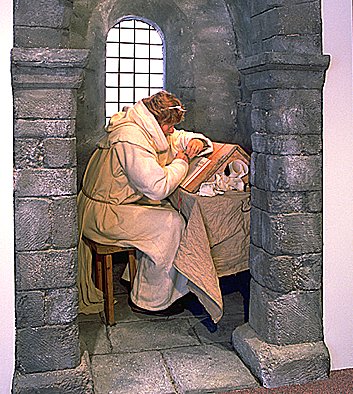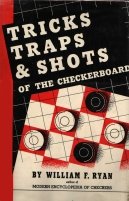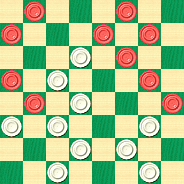The Jaques Shot

We've all heard the well-known French children's song Frere Jaques, but we'll guess that relatively few of us are familiar with its origins and possible meanings. Frere Jaques is usually translated as "Brother John," but "brother" can refer to a monk as well as a sibling. In fact, there's some evidence that Frere Jaques is related to Girolamo Frescobaldi's Fra Jacopino, lending credence to the "monk" theory.
We don't think Fra Jacopino, or Frere Jaques for that matter, were checker players, though perhaps they knew of an older version of the game. In any case, the subject of today's column, a different Jaques, was certainly a checkerist. Willie Ryan, in his seminal work Tricks Traps & Shots of the Checkerboard, gives us the scoop.

"One of the prettiest of all strokes is the much heralded Jacques Shot. E. Jacques, of Canada, used it for the first time in defeating a player by the name of Campbell, first name unknown. Invariably, writers have used the order of moves played in the Campbell-Jacques game to illustrate the stroke, but as explained in my note B, this invalidates the scientific value of the coup. It is neither practical nor advisable to make a losing move to bait a trap. Any experienced player knows better than to take such a risk. In my treatment of the Jacques stroke, the correct order of moves is given so that white can play for the shot without making a losing move at any point.
| 9-13 | 11-16 | 13-17 |
| 24-19 | 25-21 | 31-26---3 |
| 11-16 | 6-9 | 9-13---4 |
| 22-18 | 23-18 | 25-22 |
| 8-11 | 16-23 | 12-16 |
| 28-24 | 26-19 | 15-10 |
| 16-20 | 4-8---A | 2-7---C. |
| 18-14 | 29-25 | Now see the |
| 10-17 | 7-11---B | diagram. |
| 21-14 | 19-15 |

WHITE
White to Play and Win
W:W32,30,27,26,24,22,21,18,14,10:B20,17,16,13,11,8,7,5,3,1.
A---The following is much stronger---1, and almost makes the run-up on the Jacques Shot untenable: 13-17, 18-15* (the only move to draw), 9-18, 21-14, 18-22, 30-25*, 7-10, 14-7*, 2-18, 27-23*, 18-27 (20-27, 23-14, 22-26, 32-23, 26-30, 25-21, 1-6, 23-18, a draw), 25-18, 5-9, 32-23, 20-27, 31-24, 9-13, 19-15, 13-17, 18-14, 17-22, 14-10, 22-26, 23-19, 4-8, 24-20*, 26-31, 20-16, 31-27, 29-25*, 27-24 (27-23, 25-22*, 23-27, 10-6*, a draw), 16-11, 24-20, 11-4, 20-16, 4-8, 16-23, 15-11, 12-16, 8-12, etc.; a draw. Wm. F. Ryan.
B---If 8-11 is played here, then white's only move to draw is 25-22*---2. In the historical Campbell-Jacques game, 13-17 was played; white (Jacques) replied with 31-26, which loses for black by: 8-11, 32-28 (25-22, 11-15, black wins), 17-22, 26-17, 11-15, 19-10, 9-13, 25-22, 5-9, 14-5, 7-32, 24-19, 32-27, etc. F. F. Smith, Birmingham, England. However, if after 13-17 at B, white replies with: 18-15, 9-18, 21-14, a draw by black will be difficult. Hence, to reach the Jacques Shot scientifically without either side making a losing move, 7-11 must be played before 13-17, as the latter move virtually loses at this point.
C---The losing move, and it forms the great Jacques Stroke. Although this classical 12-piece clearance has been essayed and acclaimed by 1001 writers on the game, not one has ever attempted to show black's losing move, nor has any authority ever published the play leading up to the shot in the proper scientific sequence. This is not unlike a musician with rheumatic fingers trying to do justice to a fine rhapsody on a rusty instrument that is out of tune. My examination of the situation shows that instead of 2-7 at C, black can effect the following beautiful draw, two pieces short: 16-19*!, 24-15, 2-7*, 27-24, 20-27, 32-23, 5-9, 14-5, 7-14, 18-9, 11-27, 21-14, 3-7*!, 26-23, 27-31, 23-19, 13-17*!, 22-13, 8-11, 30-25, 31-27, 25-21, 27-23, 21-17, 23-16, 9-6, 1-10, 5-1, 16-12, 13-9, 10-15, 1-6, 11-16. Wm. F. Ryan. This draw is almost as good as the shot!"
1---The computer doesn't see any real difference between the two moves---Ed.
2---The computer gives 32-28 to draw and sees 25-22 as a possible White loss---Ed.
3---A probable loss for White; 30-26 was required here. We're a little surprised Willie missed this---Ed.
4---But Black gives away all the advantage. 11-16 likely would have won---Ed.
You don't need to be a monk, speak French or Italian, or be familiar with musical history to solve the problem diagrammed above. You do need to be a pretty good checker player, though. When you've found la solution (or should that be la soluzione?) click your mouse on Read More to check your work.![]()
Solution

WHITE
White to Play and Win
W:W32,30,27,26,24,22,21,18,14,10:B20,17,16,13,11,8,7,5,3,1.
5---7-14 transposes back to the main line---Ed.
6---10-14 or 10-15 no different---Ed.
You can email the Webmaster with comments on this article.